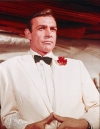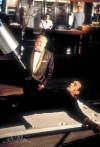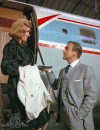Bullz-Eye continues its look back at every James Bond film, 007 One by One, as part of our James Bond Fan Hub that we’ve created to celebrate the 50th anniversary of the first Bond film.
The third Bond film is more than one of the most enduringly popular movies in the series, it’s the template for James Bond movies from that point forward. In fact, it’s fair to argue that it actually set the pattern for actions films for years to come. It was also arguably the first modern-day blockbuster in that it was intended as an event as well a movie — complete with mega-bucks generating merchandizing opportunities. Sadly, it’s also the first movie in the series that Bond’s 56 year-old creator, Ian Fleming, didn’t live to see completed. He could not have conceived of how insanely popular his creation would become within months of his passing.
“Goldfinger” (1963)
The Plot
007 locks deadly horns with a mysterious millionaire known for cheating at gin rummy, golf, and the exportation of gold. That naturally turns out to be only the tip of the iceberg as James Bond discovers a diabolical plan aimed at destroying the economy of the free world and making portly Auric Goldfinger (Gert Fröbe) the world’s richest man. The aptly named, gold-obsessed supervillain’s target is, of course, Fort Knox.
The Backstory
With the back-to-back success of “Dr. No” and “From Russia With Love,” the cash-conscious EON producing team of Harry Saltzman and Albert R. “Cubby” Broccoli were ready to spend big money in early 1960’s movie production terms — $3 million! (The 2008 Bond entry, “Quantum of Solace,” had a reported production budget of $200 million.)
Dashing director Terrence Young, who had launched the series so ably with “Dr. No” and “From Russia With Love,” went for the gold and held out for more pay. True to form, EON decided to go with a more thrifty option and brought in an accomplished journeyman director who was, nevertheless, a new hand when it came to staging elaborate action scenes, Guy Hamilton.
American writer Richard Maibum was back on board, this time with an assist from British screenwriter Paul Dehn. A likely inspiration for the dashing English spy played by Michael Fassbender in “Inglourious Basterds,” Dehn was a former film critic and admitted World War II assassin. His next gig was, ironically, helping to adapt John le Carré’s specifically anti-Bondian espionage classic, “The Spy Who Came in From the Cold.”
Most importantly to the financial bottom line, Sean Connery had made himself synonymous with 007 and was also on board for another go round, though he wouldn’t appear on set until he finished off his highly dramatic starring role in Alfred Hithcock’s “Marnie.” Connery was starting to worry a little about this whole business of being typecast as a veritable superhero; he would continue to go out of his way to remind the public he could be someone other than Bond.
Researching the film today, everyone working on “Goldfinger” seems to have understood the massive opportunity it presented. That bigger budget meant one thing: more — more action, more gadgets, more violence, and an extremely fast pace by the standards of its day. It was just the kind of wretched excess that could lead to a film so enormous it could launch easily the longest lasting and most consistently successful franchise in movie history.
The Bond Girls (Rule of 3 + 2)
Bond keeps to his usual score of three sex partners per movie. However, as befits the more lavish “Goldfinger,” we actually have five legitimate “Bond girls” this go-round. It’s just that Bond respectfully keeps his hands off of one and apparently never quite reaches home plate with another. To be specific…
Bonita (Nadia Regan) — She gets kissed while naked at the end of the pre-credit sequence, but it appears that actually doing the deed with Bond was never in the treacherous beauty’s plans, and she ends up with only a nasty bump on the head for her trouble. The adorable, Serbian-born Nadia Regan was actually on her second Bond go-round, having played a very brief kittenish role in the just-prior, “From Russia With Love,” where she was the Turkish secretary/girlfriend of Ali Kerim Bey (Pedro Armendariz.)
Dink (Margaret Nolan) – This lovely bathing beauty and amateur masseuse appears to be Bond’s very temporary girlfriend during his very short vacation at Miami Beach’s ultra-lux Fontainebleau Hotel. In true super-sexist style, he dismisses her with jovial rudeness and a smart smack to the backside when his American colleague shows up. Actress and model Margaret Nolan would go on to appear in a Playboy pictorial and several entries in the “Carry On” series of British sex comedies.

Jill Masterson (Shirley Eaton) – Bond wastes little time in seducing the bikini clad Masterson, who has unwisely taken a job helping a certain highly suspicious gold broker cheat at gin rummy. The superspy clearly takes a liking to the spunky, frankly sexual Masterson. He is devastated when he wakes up from a clubbing-induced slumber to find her suffocated to death by being painted completely gold from head to foot. It’s a tragic death, but it gave the movie its poster and one of the most creepily memorable and iconic images in the Bond lexicon. Shirley Eaton, already a busy working actress in the British film industry, would go on to star in a number of mostly not-so-distinguished films before retiring in favor of motherhood in 1969. She came out of retirement three decades later with a memoir, Golden Girl.
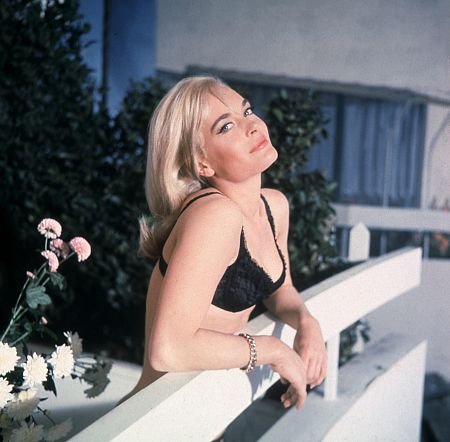
Tilly Masterson (Tania Mallet) – When Bond gets his first good look at the vengeance-seeking sister of Jill Masterson, “Discipline, 007!” he reminds himself. Still, though Bond clearly sympathizes with her need for justice, there’s simply no time for romance. In the book, Bond’s chances were even worse as Ian Fleming made it more than explicit that this Masterson sister played for the other team; she was more interested in hooking up with Pussy Galore than any man. The beautiful and sad, but also somewhat remote Tilly was played nicely by model Tania Mallet. That sadness was probably assisted somewhat by the tragic real-life death of her longtime boyfriend prior to filming. After “Goldfinger,” Mallet mostly abandoned acting in favor of her more immediately lucrative career as a model. Her only other significant role of any sort was a 1976 episode of “The New Avengers.”
Pussy Galore (Honor Blackman) — The ultimate Bond girl with the ultimate Bond-girl name, Ms. Galore is the closest thing Bond meets to his female equivalent in any of the early Bond films. Goldfinger’s personal pilot also has something going for her in that she’s not immediately attracted to Bond. In fact, careful viewers might notice that she’s not immediately attracted to men in general. Pussy Galore’s name raised enough hackles with censors and the filmmakers weren’t about to risk a total ban with an avowedly lesbian leading lady. The film plays her inclinations — and that of the other beautiful members of her fellow pilots in “Pussy Galore’s Flying Circus” — on the down-low. Ian Fleming’s novel did not play them down, however. In fact, horny homophobe Fleming threw in an overt flirtation between Tilly Masterson and Pussy — in the book the leader of an all-lesbian criminal gang called “The Cement Mixers.”
Honor Blackman was already a fairly big acting name, having preceded Bond-girl-to-be Diana Rigg as the leading lady on the popular English spy series, “The Avengers.” Blackman brought real class and grace to her portrayal of her oddly named character and, while she was typecast as Pussy for much of the rest of her career, she enjoyed success as a singer and a busy working actress of stage and screen. She continues to work both as a performer and a political activist, campaigning to eliminate the British monarchy, a cause of which we are certain 007 would not approve.
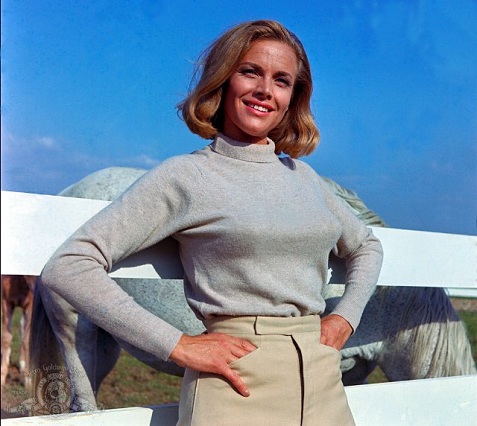
Friends and colleagues
Felix Leiter (Cec Linder) — Bond’s CIA opposite number from “Dr. No,” returns, but it sure looks like he’s had a very stressful two years. Cec Linder looked considerably older than the stolid Jack Lord (“Hawaii Five-O”), who originated the role and preferred not to return. The 42 year old Linder was actually slightly younger than Lord, but he played Leiter as a wry, very middle-aged older brother to Bond and something of a subtle comic sidekick. From “Goldfinger” on, Leiter would become a shapeshifter, being played by completely unrelated actors of varying physical types and races from movie to movie.

Moneypenny (Lois Maxwell) and M (Bernard Lee) — MI6’s most beloved secretary is back once again to flirt madly with Bond while boss man M once again cuts the flirting short so the plot, and the necessary exposition, can keep barreling forward. M gets more comic business this time around, especially during a dinner with Bond and a bigwig from the Bank of England. However, he has to make way for the first really substantial appearance by another beloved member of the growing Bond movie family.
Q (Desmond Llewelyn) — The armorer formerly known as Major Boothroyd had actually appeared in both “Dr. No” and “From Russia With Love,” but he had only been played for the first time by Desmond Llewelyn in Bond #2. Since “Goldfinger” was the first film in the series where the gadgetry took center stage, it was natural that Q branch would also have a lot more to do. So, for the first time, the man known as Q grew a discernible personality. The new film would provide Llewelyn an opportunity to show his comic chops and introduce one of the series most well loved running jokes: Q is permanently annoyed with Bond for breaking all the great toys with which he regularly presents him, and for not being particularly sorry about it. Llewelyn was so good at being irritated by 007’s flippancy that he appeared in every EON-produced Bond film until his death in a car accident in 1999.

The Nemeses
Auric Goldfinger (Gert Fröbe) – Goldfinger is, next to Ernst Stavros Blofeld, the most archetypal of Bondian supervillains. Along with his diabolical master plan and his lavish abodes, Goldfinger really knows how to stick to a theme. He keeps a staff of blonde pilots, owns a golden Rolls Royce, and he carries a gold pistol. When it comes time to do away with the lovely Jill Masterson, he has her killed by painting her body completely gold, resulting in “skin suffocation.” In the novel, he wears golden underwear and sleeps only with gold painted prostitutes.
German actor Gert Fröbe was seemingly born to play the role, but he was not yet an English speaker and his voice was provided by actor Michael Collins. Nevertheless, the tall, portly actor’s grim yet oddly humorous presence was crucial to the film’s success. He continued to make sizable contributions to a number of movies, including the epic comedy, “Those Magnificent Men in Their Flying Machines” and the big-budget children’s musical, “Chitty Chitty Bang Bang” (loosely based on an Ian Fleming novel and also featuring a gadget-filled car).
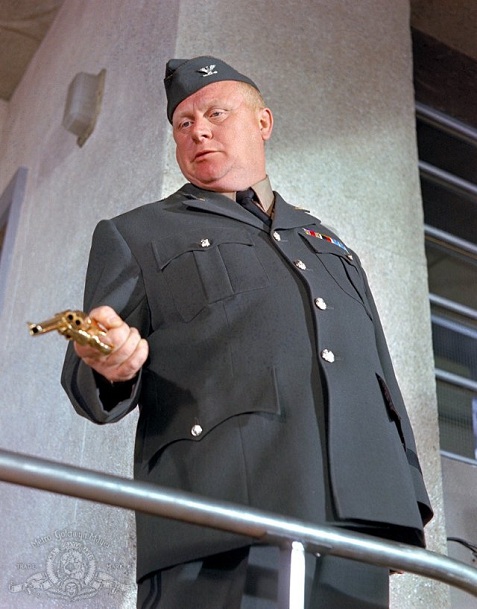
Oddjob (Harold Sakata) – No Bond villain ever had a more memorable henchmen than Goldfinger’s Korean bodyguard/manservant/paid killer. Oddjob says nothing, but his body language is killer, especially when he is flings his deadly derby hat, a sort of flying Frisbee of death. Along with his imposing presence and martial arts skill, Japanese-American Harold Sakata brought a great deal of ironic humor to the role, making the silent killer as oddly likable as he was deadly.
A former Olympic weightlifting silver medalist, the Hawaii-born Sakata came to the attention of Bond producers as a “bad guy” wrestler named “Tosh Togo.” Not at all a bad guy in real life, his good-natured, easygoing personality and work ethic made him a favorite of the “Goldfinger” cast and crew. Being Asian and more than a little bit gigantic, Sakata wound up being typecast and he was never quite free of Oddjob. At least he was able to star in our pick for the most awesome cold remedy commercial of all time.

(Short-lived) Lesser Bond Baddies
Wantonly doing away with one’s colleagues is a hallmark of any great James Bond villain. Even so, Auric Goldfinger has what has to be considered an itchy trigger finger and ends up knocking off every minor villain in the movie. First, he uses nerve gas to do away with an entire roomful of gangsters gathered at his home, while Oddjob is tasked with shooting the uncooperative Solo (Martin Benson) and having him crushed inside a Lincoln.
While invading Fort Knox, Goldfinger — wearing an U.S. Army uniform — shoots his previously trusted Red Chinese contact, Mr. Ling (Burt Kwouk), in order to blend in as G.I.’s retake the compound. Anglo-Chinese actor Burt Kwouk was, by the way, the gifted performer who portrayed Inspector Clouseau’s long-suffering houseman/sparring partner, Kato, in “The Pink Panther” series.
License to kill
Bond is on some of his best behavior here and never really uses his 00 authority. Every bad guy Bond kills here is in pretty inarguably in self-defense. Even Goldfinger dies not die at Bond’s hands but, in the style of silver age comic book supervillains who weren’t allowed to be killed by superheroes, the movie’s big bad gets conveniently sucked out of an airplane window. Interestingly, while Bond in the books tends to be less violent than in his film incarnation, in the novel Bond loses control of his anger and actually strangles Auric Goldfinger.
The gadgets and the car
No small part of the success of “Goldfinger” was the fact that it was the first film to really bring the gadgetry front and center. In this case, all those gadgets were mostly housed in one place — the world’s coolest automobile. So it was that Bond’s old Bentley was replaced with the more up to date Aston Martin DB5, as customized by production designer Ken Adam and efx genius John Stears.
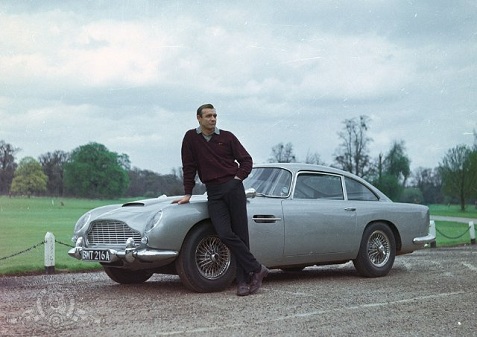
An early example of the practice we now know as “product placement,” the Aston Martin company supplied a single car (another one was later purchased). As legend would have it, the auto was originally only to have a smoke screen device, but crew members began suggesting so many other nifty devices that James Bond becomes visibly irritated as Q informs him that describing them all won’t take more than an hour.
And what devices they were. Director Guy Hamilton had been plagued by parking tickets, so he was attracted to the revolving license plates that had been mentioned in the novel. Hamilton’s stepson suggested the auto-ejector seat that caused Bond to exclaim, “You’re joking!” There was also the bullet-proof windshields, the oil slick release mechanisms, and, of course, the left and right front-wing machine guns. Not technically built into the car as a practical effect, but created largely through the magic of editor Peter Hunt, the car also came equipped with a wheel-based tire-destroying device. That idea was a more or less direct lift from the killer chariots featured in the hit 1959 biblical epic, “Ben-Hur.”
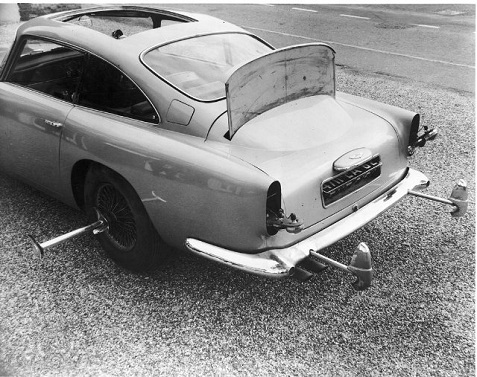
The car was, of course, a huge hit with audiences and played no small part in the enormous commercial success of the James Bond series throughout the 1960s. Corgi’s model of the Q branch Aston Martin DB5 became the most successful toy of 1964 and one of the most iconic merchandizing opportunities of all time. (It was also maybe the first toy to be aimed at children from a movie containing material thought inappropriate for kids.) The Corgi DB5 was a key part of a worldwide merchandising bonanza that would prefigure films like 1977’s “Star Wars,” financed largely on the back of its built-in merchandising possibilities. David Worrell’s out-of-print 1993 book about the DB5 was aptly entitled The Most Famous Car in the World.
The exotic attractive locales
If “Goldfinger” skimps in any area, it’s the settings. While reasonably spectacular, they really aren’t as exotic as usual. We have the pre-credit sequence set in an unnamed Latin American country, presumably Mexico; a brief sojourn with M, Moneypenny, and the Bank of England official in London; and a memorably tragic visit to Goldfinger’s compound in the relatively mundane nation of Switzerland. The rest of “Goldfinger” takes place mostly in the United States, specifically semi-exotic Miami Beach and not-at-all exotic Kentucky, near Fort Knox. Nevertheless, the film does make use of a truly spectacular post-credits aerial shot of Miami’s Fontainebleau Hotel, then the last word in opulent accommodations. It also makes use of the more mundane aspects of Louisville and is probably the first major film to give a plug to a new fast-food franchise called Kentucky Fried Chicken. Felix Leiter, in particular, seems to be a fan of what we now call KFC — though the actual restaurant where the scenes were shot was in Florida.
In reality, the bulk of “Goldfinger” was made back in England at Pinewood Studios outside of London. Sean Connery, in particular, never set foot in the U.S. during the production, leading to a lot of rather obvious process shots during the Fontainebleau sequence. Still, what the film lacked in exteriors it more than made up when it came to its interiors, which leads us to…
The outrageous villain’s lairs
Production designer Ken Adam had taken a break from the Bond films with a spectacular job creating the cavernous White House “war room” and other hugely memorable settings for Stanley Kubrick’s epochal black comedy masterpiece, “Dr. Strangelove.” His return to the series on “Goldfinger” turned out to be at least as much of a career high for Adam. Quite apart from his brilliant work tricking out the Aston Martin DB5, these sets rank easily among the most famed in movie history.
Most famous of all the “Goldfinger” sets is the enormous rumpus room located in Auric Goldfinger’s not so old Kentucky home. Looking a little bit like a hunting lodge gone ultra-modern, with a gigantic pool table that turns into a control panel operating a number of devices, it houses equally gigantic models of Fort Knox that literally come out of the woodwork. This was a few decades before PowerPoint, and these models make memorable visual aids as Goldfinger partially explains his evil “Operation Grand Slam” to a group of skeptical crime kingpins.
The room later turns out to also be a giant gas chamber in which the supervillian will kill the criminals he has just worked so hard to sell on his plan. Goldfinger clearly enjoys explaining his diabolical plans to people he plans to kill even more than most Bond villains.
On a serious note, many commentators have noted an especially disturbing side to the gas chamber designed by Adam. A German Jew, Ken Adam had come to England as a young wartime refugee and eventually joined the Royal Air Force (RAF), serving with notable heroism. Though Adam denied any conscious associations, it’s hard not to imagine that the genocidal crimes of the Nazis weren’t on his mind on some level as he designed the room.
Other notable villain-lairs include the Latin American drug silo that Bond blows up in the pre-credit sequence, Goldfinger’s ultra-posh Fontainebleau suite where Bond seduces Jill Masterson in record time, and the laser room where Bond nearly comes to an unpleasant parting of the ways. Finally, though it’s not a villain lair, we have to at least give a shout out to the film’s imaginative and striking depiction of the interior of Fort Knox. Fort Knox is so secure and super secret not even the U.S. president is allowed inside of it, so of course the film makers were not allowed to see its interior. Adam later admitted that he was glad to have no reference, as he was able to make up his own idea of what the place looked like inside.
The Opening
“From Russia With Love” had already used the then-unusual device of a pre-credit “teaser” opening, but “Goldfinger” took the idea one step further. While the opening of the prior film was fairly similar to the “cold open” of a sixties TV drama, in that the action hinted at the main story to come, the opening of “Goldfinger” amounts to a miniature James Bond adventure.
Though completely unrelated to the main story in terms of plot, it brilliantly sets up the more overtly tongue-in-cheek nature of this film right away: Our hero snorkels his way into a heroin processing compound, camouflaged by a drenched stuffed duck attached to his head. Almost without breaking a sweat, Bond places some plastic explosives in a silo housing a drug lab. In perhaps the sequences most famous shot, he removes his wet suit, revealing an immaculate tuxedo. The ever meticulous Bond even has a small rose ready to use as a boutonniere. Entering a nearby cantina to greet his contact, he is the only person not to react to the gigantic explosion he has set off — an early version of the “cool guys don’t look at explosions” phenomenon. Later, an intimate encounter with Bonita, a dancer in the bar, comes to a deadly end as a reflection’s in her eyes (have you ever seen a reflection in an eyeball?) reveals her true purpose. For the first — but definitely not the last — time, Bond uses a treacherous woman as a human shield to survive an encounter with a would-be killer, whom Bond then dispatches with the first of his famously groan-inducing post-mortem quips.
The overall message of the opening is clear and simple: prepare for big fun and, whatever you do, do not take any of this too seriously.
The Credits
Designer Robert Brownjohn returns for his second and final Bond credit-sequence outing, using the same process as he used in the “From Russia With Love” credits. As the title song plays, scenes from the film are projected on a scantily clad female body, but this time it’s a golden painted one. As strong as Brownjown’s visuals are, however, what really makes those credits is the greatest of all Bond theme songs…
The Music
John Barry had proven himself far more than able in various musical capacities on the first two Bond films. So, even though he had never before written a pop hit, he was finally allowed to write the music for the opening song, and what a song it was.
The brassy opening bars of “Goldfinger” announce melodramatically that we are in for an adventure of vast proportion and the music is jazzy yet almost operatic in scale. The lyrics, from the theatrical songwriting team of Leslie Bricusse and Anthony Newley, were inspired by Bobby Darin’s unlikely hit version of Bertolt Brecht and Kurt Weil’s “Mack the Knife,” (the only megahit we know about a thief, murderer, and rapist). As Barry had no problem admitting, the astonishing, hell-bent-for-leather vocals of singer Shirley Bassey were crucial to selling the outrageous lyrics, a warning that gold-obsessed millionaires may not be good boyfriend material. The song was, of course, a tremendous hit. It remains easily the greatest Bond theme and, for all its near-camp excess, one of the greatest movie theme songs of all time. The rest of the film’s score isn’t so bad, either.
Action Highlights
Though it might feel a bit leisurely next to frenetic modern day action flicks, “Goldfinger” has the most action of any Bond film up to that point. That action is underlined by the ace work of editor Peter Hunt, whose “crash cutting” style propels the film ever forward and even makes a golf game exciting and fun to watch.
Easily the most famous action sequence in “Goldfinger” is the final face-off between Bond and Oddjob inside Fort Knox. Harold Sakata, Sean Connery, and stunt double/stunt coordinator Bob Simmons performed some of the most bruising action of the entire series during a fight which very nearly one-ups the spectacular fight sequence with Robert Shaw in “From Russia with Love.” Connery apparently sustained some kind of back injury during the Fort Knox fight, which Connery’s representatives are supposed to have used as a bargaining tool when negotiating his salary for the upcoming “Thunderball.”
Harold Sakata reportedly sustained a more serious injury during the moment when he is “electrocuted.” Apparently, something went wrong and Sakata’s hand made direct contact with burning pyrotechnic material. Such was Sakata’s commitment, he held on to the bar tenaciously until director Guy Hamilton yelled “cut!”
Another battered “Goldfinger” star was, of course, the Aston Martin DB5 which received plenty of “wear and tear in the field” during the Switzerland sequence. First, there is the encounter between Bond and the mysterious armed woman who turns out to be the revenge-seeking Tilly Masterson, in which Bond gets the upper hand via the “Ben-Hur”-inspired tire destroyer. Most of the car’s other devices get used during a later chase through Goldfinger’s home offices as he evades scores of North Korean and/or Chinese henchmen as well as a little old lady armed with a machine gun — a touch none other than Alfred Hithcock openly envied for its black humor.
Finally, Bond and Pussy Galore’s final confrontation with Goldfinger on board his private jet deserves some mention for visual bravado and questionable physics as a gun shot causes the plane to depressurize and plummet. While uberbaddie Goldfinger meets an undignified end, somehow Bond and Galore manage to escape with parachutes…how?
Speaking of physical action and Pussy Galore, the two have a famous/infamous tussle in the hay in one of Goldfinger’s horse barns, which naturally ends in romance. It was something of a cliché in fifties and sixties movies for the man to force a kiss on an initially resisting woman who, after a token struggle, passionately returns the hero’s affections. Today, of course, this kind of behavior is deemed sexual harassment at best and rape at worst. Intriguingly, Goldfinger’s seduction scene actually comes across more playful and a lot less offensive than most scenes of this type, perhaps because Pussy is arguably Bond’s equal in many respects. When she kisses Bond back, we’re pretty sure it’s not her weakness or fear, but her suddenly awakened feelings that are driving her. Pussy is nobody’s doormat.
The one-liners
Though the early Bond films certainly didn’t lack for a sense of humor, “Goldfinger” is the movie that really embedded funny and/or groan-inducing one-liners and quips into the Bond canon. Some are witty, some are dopey, some are snobby and intriguingly dated, but they are all a huge part of the fun of “Goldfinger.”
Bonita (annoyed by Bond’s gun): “Why do you always wear that thing?”
Bond: “I have a slight inferiority complex.”
Bond (surveying the freshly electrocuted corpse of his would-be killer): “Shocking, positively shocking!”
Goldfinger: “Choose your next witticism carefully, Mr. Bond, it may be your last.”
Bond (watching a deadly laser beam get ever closer to his crotch): “Do you expect me to talk?”
Goldfinger: “No, Mr. Bond, I expect you to die.”
Radio: “At the White House today, the president said that he was entirely satisfied…”
Bond (postcoitally canoodling with Jill Masterson): “That makes two of us.”
Bond (noticing his champagne has lost its chill:) “My dear girl, there are some things that just aren’t done, such as drinking Dom Perignon ’53 above the temperature of 38 degrees Fahrenheit. That’s just as bad as listening to the Beatles without earmuffs.”
Pussy: “My name is Pussy Galore”
Bond: “I must be dreaming.”
Bond: “You’re a woman of many parts, Pussy.”
Cocktails and alcoholic beverages
Just as it ups the ante on action and sexiness, “Goldfinger” keeps the drinks coming. Not long after the tragic aftermath of that insufficiently chilled champagne, Bond gets into a colloquy on a “disappointing” Cognac with Colonel Smothers of the Bank of England. Bond offers a prompt diagnosis: “I’d say it was a 30 year old finé, indifferently blended, sir,……..with an overdose of Bon Bois.” Neither 99.9% of the audience, nor M understands what the hell Bond is talking about and Bond’s boss is clearly not pleased. (Bon Bois, it turns out, is a portion of the Cognac region of France whose grapes are considered slightly less fitting for a truly superior brandy than some others.)
Later, for the first time in any movie, it’s Bond himself who makes the most famous drink order in movie history. You’d think Bond would request a very strong coffee after awakening from a tranquilizer dart-induced sleep, Instead, he requests strong drink from one of Goldfinger’s prettier minions. “A martini, shaken, not stirred.” Without going into an extended colloquy on the debate among mixologists and cocktail connoisseurs, it’s interesting to note that the movie Bond usually orders a vodka martini with this suggestion, a somewhat less controversial choice than ordering a gin martini shaken, which he also does. Apparently Bond, like Ian Fleming, liked all his martinis to be shaken whether they were gin or vodka based.
Speaking of Fleming, in the books, Bond imbibed at least as much good old American bourbon as anything else and “Goldfinger,” with its rural American setting, gives Bond a chance to quaff what might be his actual favorite spirit. Indeed, he specifically mentions to Pussy that he understands the “bourbon and branch water is rather splendid here in Kentucky.” (“Branch water” is water from a stream, ideally the same stream where the bourbon manufacturer gets its water.) Later, Goldfinger offers Bond a “traditional, but satisfying” mint julep and Bond politely requests his be “sour mash, but not too sweet, please.” (Sour mash is a process using previously fermented material that is thought to result in somewhat sweeter tasting whiskey.) Later, Goldfinger checks to ask if Bond’s beverage is tart enough for his taste. The politeness between Bond and his supervillainous hosts can be quite touching.
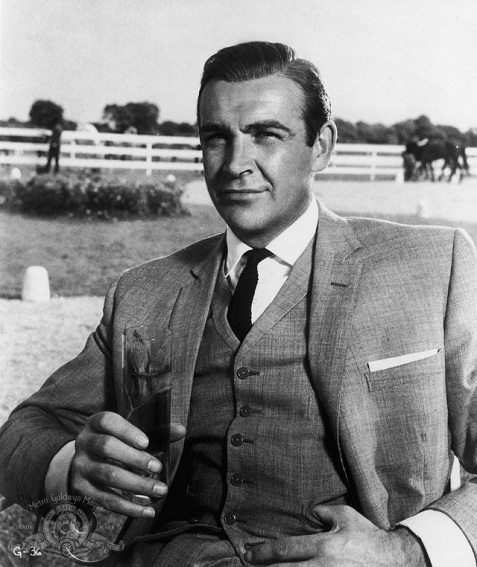
Random facts
* It sounds modest by modern standards, but “Goldfinger” generated over $51 million at the U.S. box office. (Adjusted for inflation, it’s the 41st top grossing U.S. release of all time.) “Goldfinger” was, however, a worldwide box office bonanza by any definition. It escalated the already growing worldwide vogue for espionage films into the highest end of the movie stratosphere, generating endless knock-offs and spy spoofs made all over the world. The next film, “Thunderball,” generated even more cash, though “Goldfinger” may remain the most widely seen of the early Bond films.
* “Goldfinger” was one of only two Bond movies to win an Oscar. It went to sound effects editor Norman Wanstall. It received no other nominations.
* The most obvious plot change from Ian Fleming’s novel in the film version resulted from a point raised by many critics. Goldfinger’s original plan of simply robbing Fort Knox was physically impossible. As screenwriters Richard Maibum and Paul Dehn have Bond point out himself in the movie version, it would take weeks for even a large team of robbers to remove most of the gold from the Kentucky compound. Therefore, the diabolical plan in the film is to explode a relatively small but “very dirty” atomic bomb inside Fort Knox, making the gold deadly for nearly a century and therefore drastically raising the value of Goldfinger’s gelt.
* One of the most widely noted flubs in movie history occurs when Bond needs the help of an expert to disable Goldfinger’s atomic bomb at the end of the Fort Knox sequence. Bond says “Three more ticks and Mr. Goldfinger would’ve hit the jackpot.” However, an insert shot of the bomb indicates that exactly “007” seconds were left on the counter before Bond and company would have been blown to nuclear bits. The visual joke with the timer was a last minute addition, and apparently nobody bothered to have Connery re-loop the dialogue.
* The name “Goldfinger” might sound made up, but Ian Fleming seems to have largely modeled his bad guy after the very real Erno Goldfinger, an infamously humorless avant garde architect with pro-Soviet sympathies whom Fleming despised. The real Mr. Goldfinger was, naturally, none too happy at the prospect of receiving endless prank calls and was ready to sue prior to the publication of the book, but pop-cultural disaster was averted with an out-of-court settlement. Ian Fleming had threatened to use an alternative title: “Goldprick.”
* Speaking of names and genitalia, the monicker “Pussy Galore” was just as problematic in 1963 as you might expect. “Dirty words” with double meanings were less commonly used and understood in the early sixties, but the non-feline meaning of “pussy” was the same then as today. TV promotions routinely failed to mention the name.
* “Goldfinger” was reportedly banned in Israel for a few months because Gert Fröbe had admitted in an interview to having been a member of the Nazi party before World War II. The ban is supposed to have been lifted after a Jewish family publicly thanked the actor for helping them to escape from Hitler’s Germany; it was possible that the actor had used his party membership to help smuggle a number of Jews out of the country. Fröbe, also a lifelong violin virtuoso died in 1988. In 2000, his image appeared on a German postage stamp.
* Other actors considered for the role of Auric Goldfinger included Orson Welles and actor and singer Theodore Bikel. The legendary Welles was rejected for asking for too much money, and his literally and figuratively outsize presence might have thrown the film off-balance. Screen tests reveal, however, that the relatively trim Bikel would have been a very reasonable choice.
* At the time of filming, Jill Masterson’s death-by-paint was believed to be a feasible method of murder. Indeed, just as described by Bond in the film, a small area of Shirley Eaton’s body was left unpainted to keep her safe. (A doctor was also on call.) Today, we know that any deaths caused by being painted head to toe are caused by heat exhaustion and certainly wouldn’t kill a person quickly enough to suit Goldfinger and Oddjob. Nevertheless, an obviously false urban legend arose that Eaton had died during the filming.
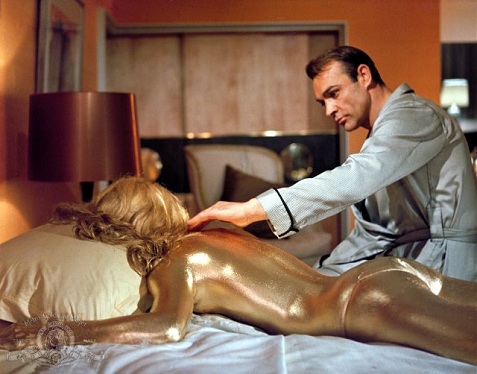
* The money conscious EON Team was forced to pay for one of the two Aston Martin DB5’s featured in the film. After the massive success of film and the notoriety of the car that resulted, it appears that Cubby Broccoli and Harry Saltzman never had to budget for a car again.
* “Solo” is the name of the go-it-alone gangster who winds up compressed inside a compacted Lincoln. It’s no coincidence that the superspy played by Robert Vaughn on the hit American spy series, “The Man from U.N.C.L.E.” is named Napoleon Solo. Ian Fleming suggested the name to the producers.
* “Goldfinger” was not only a free advertising bonanza for car manufacturer Aston Martin, the Ford Mustang driven by Tilly Masterson was also one of the legendary American car’s first film appearances. Apparently, Ford was more product-placement savvy and also supplied other cars, including the aforementioned Lincoln.
* Though he claims to have seen the movie only twice — at the premiere and many years later at the urging of his daughter — Sean Connery owes his lifelong love of golf to the film’s lengthy golf game sequence.
* “Goldfinger” plays down the part-time lesbianism of the “man-hating” Pussy Galore and her all-female flying circus, and makes a complete mystery of the proclivities of Tilly Masterson. In the book, however, the same-sex proclivities of Pussy and Tilly provide Fleming a chance to editorialize as Bond mediates on what he perceives as a growing and dangerous energy-sapping breakdown in traditional gender roles. (Bond seems to trace it all back to women being given the vote.) Similarly, Oddjob in the novel is not just a bad guy who happens to come from Korea, but is seen as being somehow typical of the Korean people. Fleming was not considered an enormous bigot by the standards of his time and place, but modern readers need to be prepared for some pretty outrageous sexism, racism, and homophobia.

The Romantic Ending
If “Goldfinger” is the model for modern action films, Alfred Hitchcock’s classic espionage thriller-comedy, “North by Northwest,” is the model for “Goldfinger.” If you’ve seen it, you know the ending essentially finesses it’s climactic literal cliffhanger with a bit of editing panache; Cary Grant and Eva Marie Saint are transported by the magic of cinema from the side of Mount Rushmore to a cozy train compartment.
In terms of sheer editorial bravado, the ending of “Goldfinger” one-ups Hitchcock as we move from Bond and Pussy in a rapidly plummeting airplane with no apparent hope of escape, to the two of them on what appears to be the nicest, safest looking island in the Atlantic with a couple of spent parachutes nearby. How the two were able to get into those parachutes and out of Goldfinger’s now-exploded plane in time to escape safely remains an eternal cinematic mystery. Clearly, Bond and Pussy owe their safety entirely to the skill of editor Peter Hunt.
When Pussy tries to signal to a search plane above, a perfectly relaxed Bond dissuades her. “Oh, no you don’t. This is no time to be rescued.” Ever mindful of his privacy nevertheless, Bond pulls one of the parachutes over the two of them as they consummate their relationship in the magic land of off-screen sex.
“James Bond Will Return”
“Goldfinger” continues the practice, begun in “From Russia With Love,” of teasing the title of the next film in the series. This time, the title card reads: “The end of ‘Goldfinger’ but James Bond will be back in ‘Thunderball.'” It appears that, probably owing to the ongoing legal dispute over “Thunderball,” the original UK title card, however, actually teased another Bond novel title, “On Her Majesty’s Secret Service.” It would eventually be filmed without Sean Connery in the lead in 1969.
Related Posts
You can follow us on Twitter and Facebook for content updates. Also, sign up for our email list for weekly updates and check us out on Google+ as well.
Posted in: Entertainment, Movies
Tags: 007, 007 50th anniversary, 007 films, 007 gadgets, 007 movies, 007 One by One, 007 one-liners, 007 villains, Albert R. "Cubby" Broccoli, Aston Martin DB5, Aston Martin DB5 James Bond, Auric Goldfinger, beautiful Bond women, best Bond movie moments, Bond babes, Bond films, Bond gadgets, Bond girls, Bond movies, Bond one by one, Bond villains, Bonita, Cec Linder, classic Bond gadgets, cognac, Corgi DB5, Desmond Llewelyn, Desmond Llewelyn Q, Dink, Felix Leiter, Fontainebleau Hotel, Gert Fröbe, Goldfinger, Goldprick, Guy Hamilton, Harold Sakata, Harry Saltzman, Honor Blackman, iconic James Bond moments, James Bond, James Bond 007, James Bond 50th anniversary, James Bond actresses, James Bond babes, James Bond blog, James Bond cars, James Bond craze, James Bond drinks, James Bond franchise, James Bond girls, James Bond henchmen, James Bond hookups, James Bond mint julep, James Bond movies, James Bond music, James Bond nemesis, James Bond one-liners, James Bond romantic endings, James Bond villains, James Bond violence, Jill Masterson, license to kill, M Bond, Margaret Nolan, martini shaken not stirred, memorable Bond scenes, Miami Beach, Moneypenny, movie blockbusters, movie merchandizing, movie one-liners, Nadia Regan, Oddjob, Paul Dehn, Pussy Galore, Richard Maibum, Sean Connery, Shirley Eaton, supervillains, Tania Mallet, Tilly Masterson





